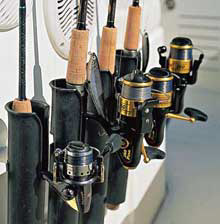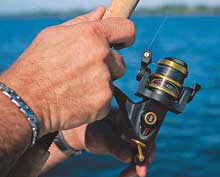Downsize your tackle for a true test of your fishing skills.
Let's face it: cranking in small-to medium-sized fish on 12- and 20-pound gear can be fun, but battling those same fish on two-, four-, six- or eight-pound test is an entirely different story. If you want to challenge your skills as an angler, ultralight is the way to go.
Going ultralight doesn't mean simply re-spooling your regular reel with lighter line. You'll need a whole new setup that complements the lighter line. For most inshore fish, choose a reel that's light and small, yet holds at least 300 yards of line. A reel that holds between 400 and 500 yards of line is recommended for taking on offshore game fish such as sailfish and tuna.
Obviously, a smooth drag is a crucial part of the equation. A "sticky" drag will lead to line damage and failure, so invest in a good reel. Also, remember that stretch and abrasion easily compromise light line, so change it after each prolonged battle with a trophy fish. It's a good idea to keep spare spools packed with fresh line in your tackle box.
Setting the DragWhen it comes to setting the drag, you can't rely on the standard "15 percent" rule (many anglers set their drags at 15 percent of the line's breaking strength). With two- and four-pound test, there should be hardly any drag at all. Use just enough resistance to keep the line from over-running on the strike or when the fish surges. During the fight, you can increase the drag by either thumbing or cupping the spool, or squeezing the line at opportune times. With eight-pound test, set the drag at two pounds for most inshore fish, and even less for sailfish or sizable offshore fish capable of making long runs.
I like to use a rod with a slightly heavier rating than the line I'm using. For example, my four-pound-test ultralight outfit consists of a Penn Slammer 260 spinning reel and a rod rated for eight- to 15-pound test. The slightly heavier rod gives me the extra backbone to set the hook and move the fish if it sulks.
Ultralight gear also demands an adjustment in hook and leader size. Given the inherent stretch of monofilament line (up to 25 percent of the line's breaking strength), you'll need to use thin, light-gauge hooks in sizes 1/0 to 4/0. With artificial lures, select ones with small treble hooks, as opposed to those with double-strength hooks. Or you might opt to swap out hooks entirely - replacing heavier hooks for lighter ones.
Make a Wind-On Leader
It's also essential to protect the line from contact with vegetation, structure or the fish itself. One slight knick and the fight will be over. A wind-on leader that's just strong enough to guard against abrasion from the fish's mouth, yet light enough to facilitate setting the hook, is the key. As with hook selection, it's important to use a leader that's not too heavy.
For most "small" fish, such as mackerel, redfish and sea trout, I'll tie a short Bimini twist in the end of the main line, followed by four feet of 20-pound-test fluorocarbon leader. I'll join the two sections with a Bristol knot (see "Basic Knots & Rigs" on page 42) a strong yet unobtrusive knot that passes easily through the rod guides and line roller. For toothy predators, I add a 12-inch section of light wire, joining it to the fluorocarbon with a SPRO power swivel or an Albright knot.
When taking on larger fish, such as dolphin, tarpon, snook and king mackerel, I'll make the wind-on leader ten to 15 feet long and go with 30- to 50-pound fluorocarbon. The extra length protects the line from brushing against the fish's body. The wind-on leader also allows me to apply extra pressure during the critical stage of the fight when the fish is near the boat.
Hook Them Close
With ultralight tackle, it helps if you can hook the fish close to the boat, as there will be less stretch in the line. If the situation allows, try to chum or tease the fish in close before presenting your bait or lure. This is especially important if you're fishing near heavy structure. The farther a fish has to run to get back to its lair, the better your chances of stopping it.
Species such as bluefish, bonito, tuna and mackerel can be chummed up behind the boat fairly easily with ground menhaden, silversides or herring. Structure-loving fish such as snook, striped bass, tarpon and even trout and redfish can often be lured away from structure by live chumming with pilchards, herring, peanut bunker and shrimp.
To hook the fish, cup or thumb the spool just long enough to set the hook, then release the tension as soon as the fish takes off. This is where reaction time becomes critical.
When a fish takes off on its initial run, hold the rod high overhead to keep as much line out of the water as possible. This helps minimize the threat of a cut-off caused by contact with flotsam, coral and vegetation, especially if the fish is hooked in shallow water. Have the helmsman give chase and keep the fish close.
Make Chase
During a long run, back off the reel drag even more. Remember that the drag caused by water resistance will increase as more line enters the water. Do not try to turn the fish by cupping the spool or using the rod. The trick is to let the fish wear itself out. During this stage of the fight, your job is to hold the rod high and let the fish do its thing. When the fish slows or sulks, and as the helmsman closes the gap, wind on line at a pace that enables you to keep a straight and somewhat taut line to the fish.
Should the fish take off again as the boat closes in, simply let it run. The time to pressure the fish is when it stops to rest. As the fish tires and its runs grow shorter, increase the drag by pressing on the reel spool or lightly squeezing the line, and use the rod more. It's a give-and-take situation, and you'll need to develop a feel for when to let the fish take line and when to increase the drag and take line back.
It's a challenge to beat fish on ultralight gear, but some anglers wouldn't have it any other way. To spice up your day with small fish on light tackle or establish a "personal best" catch, give ultralight a try.
It could be habit-forming.



